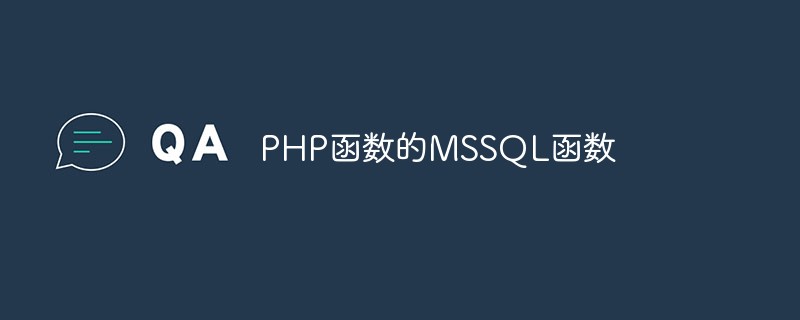 Backend Development
Backend Development PHP Tutorial
PHP Tutorial PHP function introduction—in_array(): Check whether a specific element exists in the array
PHP function introduction—in_array(): Check whether a specific element exists in the arrayPHP function introduction—in_array(): Check whether a specific element exists in the array
In PHP, there are many built-in functions that can be used to process and operate arrays. One of the very useful functions is the in_array() function. The purpose of this function is to check whether a specific value exists in the given array. It can help us quickly determine whether an element exists in the array, thereby facilitating related operations.
Syntax:
bool in_array ( mixed $needle , array $haystack [, bool $strict = FALSE ] )
Parameter description:
- $needle : The value to be found can be any type of element.
- $haystack: Array to be found.
- $strict: Optional parameter, if set to TRUE, the in_array() function will compare data types.
Return value:
If found, return TRUE; otherwise, return FALSE.
Below we use some sample code to demonstrate the use of the in_array() function.
Example 1: Basic Usage
$fruits = array("apple", "banana", "orange", "grape");
if (in_array("banana", $fruits)) {
echo "找到了banana!";
} else {
echo "没有找到banana!";
}Output:
Found banana!
Explanation: In the above example, we defined a container containing four fruits Array $fruits. We use the in_array() function to check if there is an element with the value "banana" in the array. Since the element does exist in the array, "Found banana!" is output.
Example 2: Using strict mode
$numbers = array(1, 2, "3", 4, 5);
if (in_array("3", $numbers, true)) {
echo "找到了3!";
} else {
echo "没有找到3!";
}Output:
3 not found!
Explanation: In the above example, we defined a string containing numbers and characters Array of strings $numbers. We use strict mode to compare elements, which requires both the value and type of the element to be equal to the target value. Since "3" in the array is a string, not a numeric type, in strict mode, the in_array() function does not find a matching element. So the output is "3 not found!".
Example 3: Find in a multidimensional array
$people = array(
array("name" => "John", "age" => 20),
array("name" => "Mary", "age" => 30),
array("name" => "David", "age" => 25)
);
if (in_array(array("name" => "Mary", "age" => 30), $people)) {
echo "找到了Mary!";
} else {
echo "没有找到Mary!";
}Output:
Mary found!
Explanation: In the above example, we defined a A two-dimensional array of associative arrays $people. We use the in_array() function to check whether there is an element that exactly matches the specified associative array. Since the element does exist in the array, "Mary found!" is output.
Summary:
The in_array() function is a very practical function in PHP. It can help us quickly check whether a specific element exists in a given array. This is very convenient when working with arrays. When using this function, we can choose whether to enable strict mode to compare elements. In addition, we can also search in multi-dimensional arrays.
In daily PHP development, we often need to determine whether an element exists in an array. The in_array() function can help us quickly solve this problem. I hope the above example can help you better understand and use the in_array() function.
The above is the detailed content of PHP function introduction—in_array(): Check whether a specific element exists in the array. For more information, please follow other related articles on the PHP Chinese website!
 php函数返回值可以有几个Apr 26, 2022 pm 08:14 PM
php函数返回值可以有几个Apr 26, 2022 pm 08:14 PMphp函数返回值只能有一个。在PHP中,函数返回值使用return语句定义,语法“return 返回值;”。return语句只能返回一个参数,即函数只能有一个返回值;如果要返回多个值的话,就需在函数中定义一个数组,将返回值存储在数组中返回。
 php传参都是字符串吗Dec 15, 2022 pm 03:07 PM
php传参都是字符串吗Dec 15, 2022 pm 03:07 PM不是,php传参可以是字符串、数字、布尔值、数组等。从PHP5.6版本开始支持传递数组参数,函数的形式参数可使用“…”来表示函数可接受一个可变数量的参数,而可变参数将会被当作一个数组传递给函数,语法“function 函数名(...$arr){//执行代码}”。
 php函数的参数赋值有哪几种Apr 24, 2022 pm 12:10 PM
php函数的参数赋值有哪几种Apr 24, 2022 pm 12:10 PMphp函数的参数赋值有3种:1、值传递赋值,将实参的值复制一份再赋值给函数的形参;2、引用传递赋值,把实参的内存地址复制一份,然后传递给函数的形参,进而将实参值赋值给形参;3、直接给函数的参数指定默认值,语法“函数名(参数变量='值')”。
 详细介绍PHP函数和方法的区别Mar 24, 2023 am 09:45 AM
详细介绍PHP函数和方法的区别Mar 24, 2023 am 09:45 AM随着互联网技术的发展,PHP已经成为了非常流行的开发语言之一。身为一个PHP开发者,了解PHP函数和方法的区别是非常重要的,因为它们在编写代码的时候都是必不可少的。在本文中,我们将详细介绍PHP函数和方法的区别。
 PHP函数的命名规范及规则May 19, 2023 am 08:14 AM
PHP函数的命名规范及规则May 19, 2023 am 08:14 AMPHP作为一种非常流行的脚本语言,有着强大的函数库支持,其函数的命名规范和规则对于开发效率和代码可读性都有着重要的影响。本文将介绍PHP函数的命名规范及规则。一、命名风格在PHP中,函数名需要严格符合命名规范和规则,规范主要包括两个方面:命名风格和命名规则。1.下划线命名法下划线命名法是PHP函数命名最常用的方式,也是官方推荐的一种方式。遵循这种方式的函数名
 PHP函数的迭代器函数May 19, 2023 am 08:11 AM
PHP函数的迭代器函数May 19, 2023 am 08:11 AM随着现代编程语言的不断发展,编程的效率和功能性也不断提高,其中PHP作为一种广泛使用的服务器端脚本语言,也在不断地更新和完善其自身的功能列表。PHP函数的迭代器函数就是其中的一种新功能,为PHP程序员提供了更加灵活和高效的编程方式。在本文中,我们将详细介绍PHP函数的迭代器函数的相关知识。什么是PHP函数的迭代器函数?在介绍PHP函数的迭代器函数之前,我们首
 PHP函数的MSSQL函数May 18, 2023 pm 11:31 PM
PHP函数的MSSQL函数May 18, 2023 pm 11:31 PMPHP是一种开源的服务器端脚本语言,通常用于开发Web应用程序。PHP具有易学易用、灵活、性能优异等优点,因此在Web开发领域得到了广泛应用。而MSSQL作为一种流行的关系型数据库管理系统,也被PHP所支持。在PHP中实现MSSQL数据库操作,需要使用MSSQL函数。MSSQL函数可用于连接数据库、执行查询语句、读写数据库中的数据等操作。接下来,将详细介绍一
 php中递归函数是啥意思May 31, 2022 pm 12:01 PM
php中递归函数是啥意思May 31, 2022 pm 12:01 PM在php中,递归函数指的是自调用函数,也就是函数在函数体内部直接或间接地自己调用自己;使用递归函数时,需要在函数体中附加一个判断条件,以判断是否需要继续执行递归调用,当条件满足时会终止函数的递归调用。


Hot AI Tools

Undresser.AI Undress
AI-powered app for creating realistic nude photos

AI Clothes Remover
Online AI tool for removing clothes from photos.

Undress AI Tool
Undress images for free

Clothoff.io
AI clothes remover

AI Hentai Generator
Generate AI Hentai for free.

Hot Article

Hot Tools

Notepad++7.3.1
Easy-to-use and free code editor

MantisBT
Mantis is an easy-to-deploy web-based defect tracking tool designed to aid in product defect tracking. It requires PHP, MySQL and a web server. Check out our demo and hosting services.

DVWA
Damn Vulnerable Web App (DVWA) is a PHP/MySQL web application that is very vulnerable. Its main goals are to be an aid for security professionals to test their skills and tools in a legal environment, to help web developers better understand the process of securing web applications, and to help teachers/students teach/learn in a classroom environment Web application security. The goal of DVWA is to practice some of the most common web vulnerabilities through a simple and straightforward interface, with varying degrees of difficulty. Please note that this software

EditPlus Chinese cracked version
Small size, syntax highlighting, does not support code prompt function

SublimeText3 Linux new version
SublimeText3 Linux latest version





